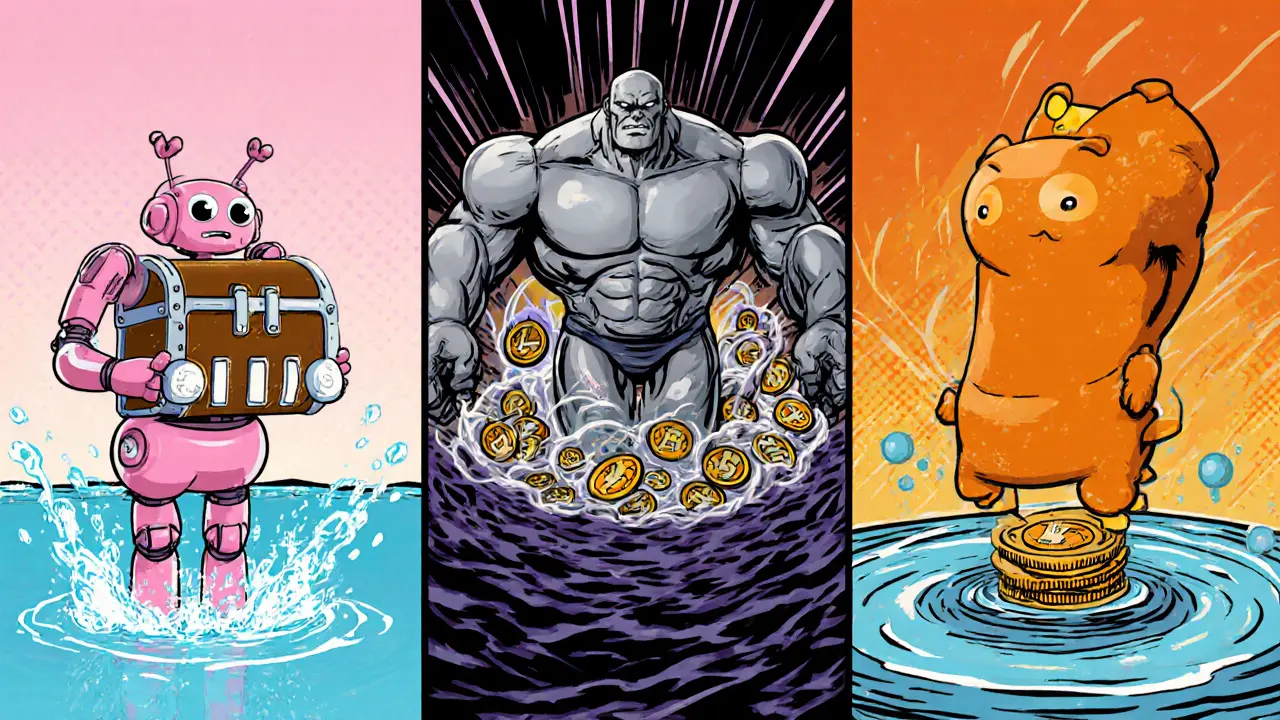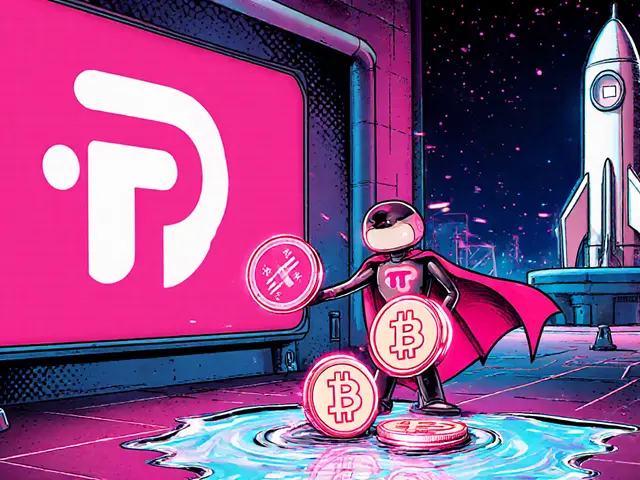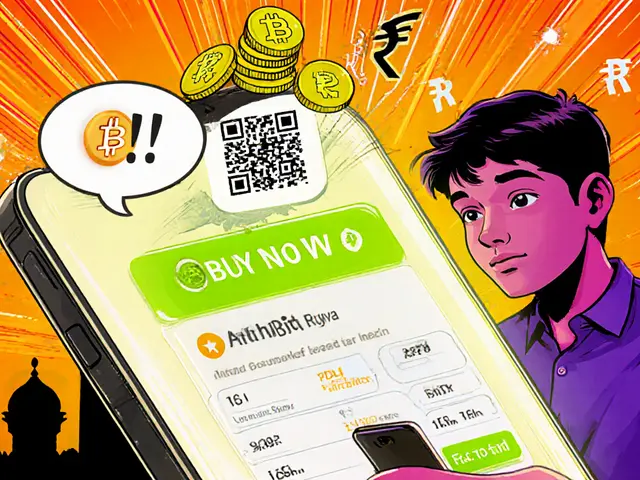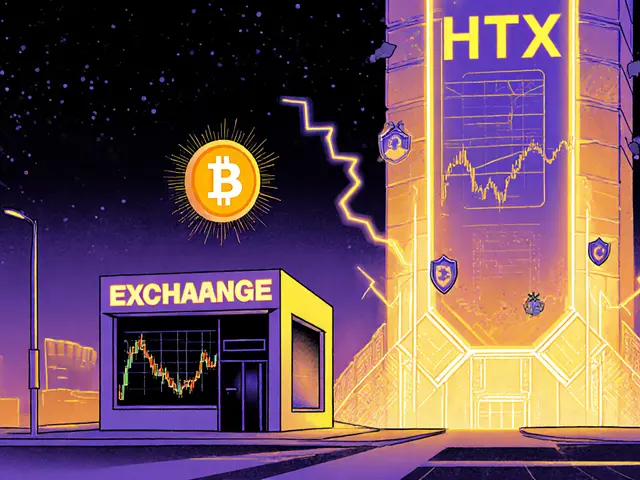PinkSwap vs. Major DEX Comparison
PinkSwap
2021 | Limited Assets
Low LiquidityUniswap
2018 | 10,000+ Pairs
High LiquidityPancakeSwap
2020 | 400+ Pairs
Medium Liquidity| Feature | PinkSwap | Uniswap | PancakeSwap |
|---|---|---|---|
| Launch Year | 2021 | 2018 | 2020 |
| Trading Pairs | 4 | ~10,000+ | ~400+ |
| Average Daily Volume | $150K | $1.2B | $750M |
| Liquidity Depth | 6th Percentile | 90th Percentile | 78th Percentile |
| Average Spread | 0.87% | 0.12% | 0.25% |
| Margin Trading | Disabled | Not Offered | Enabled (via 3rd party) |
| Fee Structure | No Market-Making Fees | 0.30% per trade | 0.20% per trade |
| Launchpad Integration | Direct via PinkSale | None | Limited (via IEOs) |
- Seamless integration with PinkSale launchpad
- No market-making fees for spot swaps
- Fully decentralized with user-controlled assets
- Very limited asset selection (only 4 pairs)
- Thin liquidity leads to high price impact
- No advanced trading features (margin, limit orders)
When you hear the term PinkSwap review, you’re probably wondering whether this niche DEX can hold its own against the giants. Launched in 2021 as part of the PinkSale suite, PinkSwap markets itself as a simple spot‑trading venue for tokens that debut on the PinkSale launchpad. In this article we’ll break down how the platform works, what you get (and don’t get), and how it stacks up against bigger names like Uniswap and PancakeSwap.
TL;DR
- PinkSwap is a decentralized exchange tied to the PinkSale ecosystem, offering 4 coins and 4 trading pairs.
- Liquidity is thin - combined order‑book percentile sits in the 6th percentile, meaning price impact can be high.
- No margin trading, no market‑making fees, but spreads average around 0.87%.
- Best for users who already launch or invest in PinkSale projects and want a curated, low‑fee spot market.
- Competes poorly on depth and variety versus Uniswap and PancakeSwap, but benefits from seamless PinkSale integration.
What Is PinkSwap?
PinkSwap is a decentralized cryptocurrency exchange that links directly to the PinkSale launchpad, providing spot‑trading for newly launched tokens. It lives within the broader PinkSale ecosystem, which also includes tools like PinkLock, PinkMoon, and PinkElon. The platform launched in 2021 and operates fully on-chain, meaning users retain custody of their assets at all times.
How the Platform Works
Because PinkSwap is a decentralized exchange (DEX), trades are executed via smart contracts rather than a central order book. When a token is listed on PinkSale, the team can add a liquidity pool on PinkSwap, allowing anyone to swap that token for the paired asset (usually BNB or a stablecoin). The DEX does not offer margin trading, futures, or complex order types - it’s a straightforward buy‑and‑sell interface.
Asset Availability
As of October2025, PinkSwap lists only four coins and four trading pairs. The limited roster could be a deliberate curation strategy, but it also means you won’t find the broad market exposure you get on Uniswap (thousands of pairs) or PancakeSwap (hundreds of pairs on BSC). If you’re hunting for niche PinkSale projects, you’ll likely find them here; otherwise, you’ll need to hop to a larger DEX.
Liquidity, Fees & Spreads
Liquidity is the Achilles’ heel of PinkSwap. The combined order‑book percentile lands in the 6th percentile, indicating shallow depth. In practice, a modest trade can move the price noticeably, especially on low‑volume pairs. The average bid‑ask spread hovers at 0.873%, which translates into a small but real cost on each transaction.
On the upside, PinkSwap disables margin trading and does not levy market‑making fees for basic swaps. This can keep costs low for casual traders, but the lack of fee discounts for higher volume users means power traders won’t see the same incentives as on larger platforms.

Security and Trust Factors
The platform benefits from smart contract audit services provided by the PinkSale team, which also runs KYC verification for token launches. However, PinkSwap itself does not publish a dedicated audit report, nor does it advertise insurance coverage. Users should therefore treat it as a typical DeFi protocol: examine the contract code (if you can) and keep only what you’re willing to risk.
Pros and Cons
- Pros
- Seamless integration with PinkSale launchpad - token creators get an immediate trading venue.
- No market‑making fees for spot swaps.
- Fully decentralized; users retain private keys.
- Cons
- Very limited asset selection - only four pairs.
- Thin liquidity leads to higher price impact.
- Lack of publicly audited contracts specifically for the exchange.
- No advanced trading features (margin, limit orders, etc.).
Competitor Comparison
| Feature | PinkSwap | Uniswap (Ethereum) | PancakeSwap (BNB Chain) |
|---|---|---|---|
| Launch Year | 2021 | 2018 | 2020 |
| Trading Pairs | 4 | ~10,000+ | ~400+ |
| Average Daily Volume (USD) | $150K | $1.2B | $750M |
| Liquidity Depth (order‑book percentile) | 6th | 90th | 78th |
| Average Spread | 0.87% | 0.12% | 0.25% |
| Margin Trading | Disabled | Not offered | Enabled (via third‑party) |
| Fee Structure | No market‑making fees for swaps | 0.30% per trade | 0.20% per trade |
| Integration with Launchpad | Direct via PinkSale | None | Limited (via IEOs) |
Who Should Use PinkSwap?
If you’ve already invested in a PinkSale token or plan to launch your own project on PinkSale, PinkSwap offers a ready‑made market without having to chase liquidity elsewhere. Casual traders who prefer low‑fee spot swaps and are comfortable with modest liquidity can also feel at home.
Conversely, high‑frequency traders, institutional players, or anyone needing deep order books should look to Uniswap or PancakeSwap. Those who require a wide array of assets or advanced order types will find PinkSwap’s feature set too sparse.
Future Outlook
The growth of PinkSwap is tightly linked to the success of the PinkSale launchpad. As more projects launch and demand for post‑launch trading rises, the exchange could add new pools, improve liquidity, and perhaps introduce advanced features. Regulatory trends around DeFi may also push the team toward formal audits and transparency, which would boost confidence.
Until then, expect incremental upgrades rather than a massive overhaul. Keep an eye on community updates - PinkSwap’s roadmap is often announced on the same channels that host PinkSale news.
Frequently Asked Questions
Is PinkSwap safe to use?
PinkSwap benefits from the audit services that PinkSale provides for token launches, but the exchange itself does not have a publicly released audit report. Users should treat it like any other DeFi protocol: use only funds they can afford to lose and verify contract code when possible.
Can I trade any token on PinkSwap?
Only tokens that have been added to PinkSwap’s liquidity pools are tradable. Currently that means four specific pairs, primarily tokens that originated on the PinkSale launchpad.
What fees does PinkSwap charge?
There are no explicit market‑making fees for spot swaps, but you still pay the network gas fees (BNB chain) and experience the built‑in spread, which averages around 0.87%.
How does PinkSwap compare to Uniswap?
Uniswap offers thousands of pairs, deeper liquidity, and a mature fee model, but it lacks the direct PinkSale integration. PinkSwap is niche, cheaper for spot swaps, but suffers from limited assets and thin order books.
Will PinkSwap add more trading pairs?
The roadmap suggests that new pools will be launched as more PinkSale projects mature. However, no firm timeline has been disclosed, so expansion will likely be gradual.




Brooklyn O'Neill
June 4, 2025 AT 22:17Hey folks, just wanted to say that PinkSwap’s integration with PinkSale is pretty neat for anyone launching a token there. The low‑fee spot swaps can really help new projects get some early liquidity without the heavy costs you see on bigger DEXs. Of course, the limited pair count means you’ll need to hop over to Uniswap or PancakeSwap for broader exposure, but for a tight‑knitted community it works well.
Ciaran Byrne
June 11, 2025 AT 02:35Useful summary, thanks.
Patrick MANCLIÈRE
June 17, 2025 AT 06:52When you compare PinkSwap to the heavyweight DEXs, a few key things stand out. First, the liquidity depth is in the 6th percentile, which translates to noticeable price impact on even modest trades. Second, the average spread of 0.87% is higher than Uniswap’s 0.12% and PancakeSwap’s 0.25%, meaning you pay more per swap. Third, the limited asset roster – only four pairs – restricts diversification and can turn away traders looking for variety. Fourth, the lack of advanced order types such as limit orders or margin trading means you’re essentially stuck with market orders, which can be risky in a thin market. Fifth, the fee structure is actually a plus: there are no market‑making fees for spot swaps, which can be attractive for low‑volume users. Sixth, the seamless PinkSale integration provides an easy launchpad‑to‑DEX pipeline for new projects, something larger DEXs don’t offer natively. Seventh, security-wise, while PinkSwap benefits from audit services for token launches, the exchange itself doesn’t have a publicly released audit, so you should treat it like any other DeFi protocol and only allocate what you can afford to lose. Eighth, gas fees on BNB Chain are generally lower than Ethereum, which can make frequent trading cheaper. Ninth, the community around PinkSwap tends to be smaller but more focused on the PinkSale ecosystem, fostering a tighter network effect. Tenth, the platform’s roadmap hints at incremental upgrades rather than massive overhauls, so expect gradual feature additions. Eleventh, regulatory trends could push PinkSwap toward more transparency and formal audits in the future. Twelfth, if you’re already invested in a PinkSale token, the immediate availability of a market can improve token utility early on. Thirteenth, for high‑frequency or institutional traders, the thin order book and limited depth are major drawbacks compared to Uniswap’s deep liquidity pools. Fourteenth, the platform’s user interface is straightforward, which is good for beginners but lacks the advanced analytics tools seen on larger DEXs. Fifteenth, overall, PinkSwap is best suited for niche users who value low fees and direct launchpad integration over deep liquidity and broad asset coverage.
Carthach Ó Maonaigh
June 23, 2025 AT 11:10Yo, PinkSwap looks like a glorified hobby shop. Four pairs? That's basically a sandbox for noobs. If you want real action, hit up Uniswap or PancakeSwap – they’ve got the juice. This thing’s spread will bleed you dry before you even realize it.
Marie-Pier Horth
June 29, 2025 AT 15:28Ah, the elegance of PinkSwap’s minimalism! One can almost hear the sweet whispers of decentralized utopia as the gas fees drift by like a gentle breeze through a meadow of infinite possibilities, each token a shining star in the night sky of financial freedom.
Gregg Woodhouse
July 5, 2025 AT 19:45meh, looks like they didnt even try
F Yong
July 12, 2025 AT 00:03Sure, PinkSwap is “secure”-if you trust a platform that doesn’t even post a full audit. But hey, who needs transparency when you’ve got a cute pink logo, right?
Sara Jane Breault
July 18, 2025 AT 04:21Great overview! It really helps to see the pros and cons side by side so new users can decide what fits them best
bhavin thakkar
July 24, 2025 AT 08:38Listen up, everybody! If you think PinkSwap’s thin liquidity is a problem, think again-dramatic price swings are the very essence of high‑risk, high‑reward trading! Embrace the chaos!
dennis shiner
July 30, 2025 AT 12:56Nice read :)
Krystine Kruchten
August 5, 2025 AT 17:14Thanks for laying out the facts. The comparison table makes it super easy to see where PinkSwap stands. Good job!
Mangal Chauhan
August 11, 2025 AT 21:31Appreciate the thorough breakdown! 😊 It’s clear that PinkSwap shines for PinkSale projects, but anyone needing deep liquidity should consider other options.
Darius Needham
August 18, 2025 AT 01:49I’m curious how the community plans to expand the pair list-adding more tokens could really boost the utility of PinkSwap beyond the PinkSale niche.
WILMAR MURIEL
August 24, 2025 AT 06:07Reading through the metrics, it’s evident that PinkSwap occupies a very specific niche in the DEX ecosystem. While the low‑fee structure and direct launchpad integration are commendable, the platform’s limited liquidity depth (6th percentile) means that traders should be prepared for higher slippage on larger orders. The spread of 0.87% further compounds transaction costs, especially when compared to Uniswap’s razor‑thin 0.12% spread and PancakeSwap’s modest 0.25% spread. For users who are already invested in tokens that originated on PinkSale, the convenience of an immediate trading venue can reduce the friction of moving assets onto larger chains. However, the lack of advanced trading features-no margin, no limit orders-makes it unsuitable for more sophisticated strategies. Security-wise, the absence of a dedicated public audit for the exchange itself is a potential red flag; while PinkSale audits its launch tokens, the DEX contracts likely benefit from the same scrutiny but that isn’t transparently documented. Gas fees on BNB Chain are generally lower than Ethereum, which can make frequent small trades more affordable, yet the overall trading volume ($150K daily) is dwarfed by Uniswap’s $1.2B and PancakeSwap’s $750M, indicating a much smaller user base. In summary, PinkSwap is best for niche participants who value low fees and seamless integration over deep liquidity and feature richness.
carol williams
August 30, 2025 AT 10:24The analysis is solid, but I’d add that the community governance aspects could also influence future liquidity incentives.
Maggie Ruland
September 5, 2025 AT 14:42Nice analysis.
jit salcedo
September 11, 2025 AT 19:00Honestly, putting all your hopes on a DEX with four pairs feels like betting on a horse with a broken leg. The odds are just not in your favor.
Lisa Strauss
September 17, 2025 AT 23:17Great job breaking this down! It’s encouraging to see honest assessments that help newcomers make informed choices.
Enya Van der most
September 24, 2025 AT 03:35Loving the energy behind PinkSwap’s niche focus! If you’re already in the PinkSale ecosystem, the low‑fee swaps can be a real boost. Just watch out for that thin liquidity.
Eugene Myazin
September 30, 2025 AT 07:53Cool summary! For anyone weighing options, it’s clear where PinkSwap fits in the bigger picture.
karsten wall
October 6, 2025 AT 12:10From a technical perspective, the limited pool size is a bottleneck, but the integration with PinkSale could drive organic growth if more projects adopt it.
Kamva Ndamase
October 12, 2025 AT 16:28The aggressive push for more listings could finally push PinkSwap out of the low‑liquidity corner, but only if they secure enough backing.
Thiago Rafael
October 18, 2025 AT 20:46While PinkSwap’s fee model is attractive, the platform’s current scale makes it unsuitable for serious traders seeking depth and reliability.
Janelle Hansford
October 24, 2025 AT 22:17Thanks for the clear comparison! It’s helpful to see where each DEX shines and where they fall short.